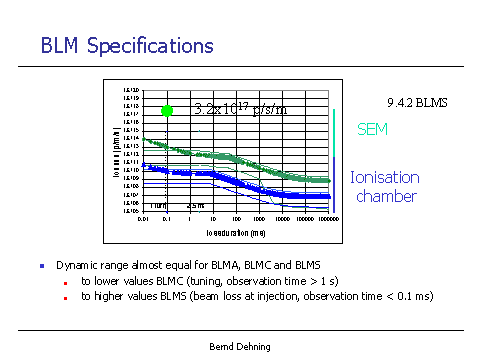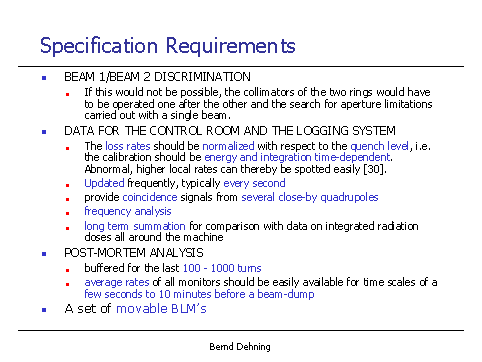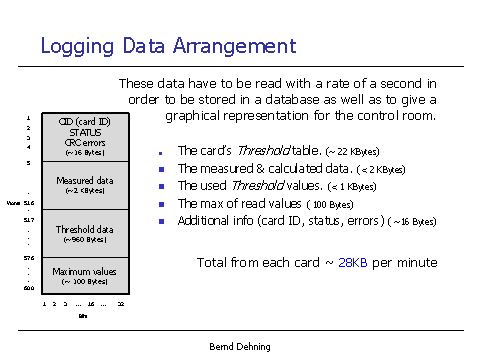
This website is no longer maintained. Its content may be obsolete. Please visit http://home.cern for current CERN information.
4000 BLMs: 3600 Ionization chambers and 400 SEM for higher loss intensities
First cut requirements spec - mid 2007
Discussion with Bernd Dehning 9th November 2004 including BLMs at HERA
Preliminary list of Requirements follow below.
Regarding your other questions, the 16 Historical properties (Historical1, Historical2,...) relate to the 16 channels connected to this card. Inside each of these properties you have a a 2D array of 20 by 12. The 20 refers to a historical sliding window (ie. each 1000ms a new reading is taken from the channels and inserted in position 20 while the existing ones are shifted left by 1). In other words, you should discard the values[0..18][] and only look at values[19][]. The 2nd dimension relates to the integration times for the BLM data:

In the operational design, the 20 historical values won't be there (there will just be 12 values per channel) - They are there now to make up for the lack of the fixed display. In the operational interface, I expect the sliding window to be at the client (your) level if needed, which will greatly reduce the overhead of sending the data (by a factor of 20!). In fact, the 'historicalX' properties won't be there at all and you will access the single 'Acquisition' property (containing 16 arrays of 12 values).
If it were me, I'd organise the the display to show only 'problem' channels (where the values were approaching a warning state), and only show 1 of the integration times (eg 0.04ms). Otherwise you're going to struggle to fit > 40'000 values on a graph :) On the other hand, it's could be useful to see many integration times for a selection of channels to see the loss evolution when there's problems.





| BLMC | Collimation | Critical | 1 turn |
| BLMS | Critical aperture | Critical | 1 turn |
| BLMA | Ring | 2.5 ms | |
| BLMB | Primary collimators | 1 turn bunch-by-bunch |
Threshold management
1,500,000 values
250 families
Crates have BOBR timing card - connected to BST.
Data pushed up on the receipt of a post-mortem event. What post event analysis needs to be done?
What, how, how often and in what format?
Comments from Ronny:
Getting hold of the contents of the post-mortem buffer i.e. turn by turn data, even when there isn't a PM event.
Haul them in along with the rest.
Lars..
1) The only reason for adding the thresholds to the BLM electronics would be
if we have:
A) Connection to the LHC injection BICs with inhibit in case losses > thresholds
B) Alarms in case the losses > thresholds
Could you please comment on A) and B)
We will have to check with Bernd what he intends to do about the thresholds as
a function of
energy as I'm not convinced the transmission via the timing system will be ready
and tested then !!
2) The single-pass transfer-line BLMs (BLMI) include monitors around the MSI
and MKI and for those I can create alarms and we can connect the system to the
BIC (TI8 or
LHC injection or both) .. Jorg is thinking about this ..